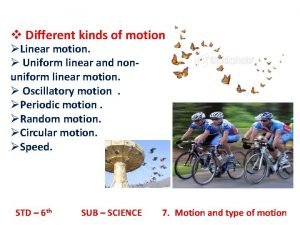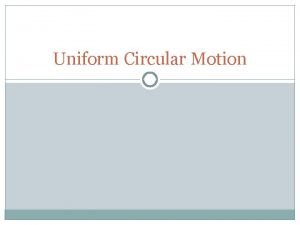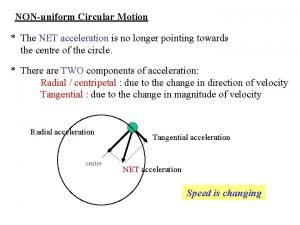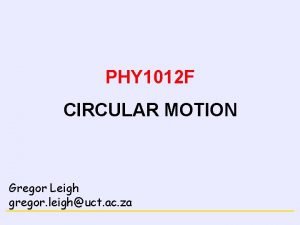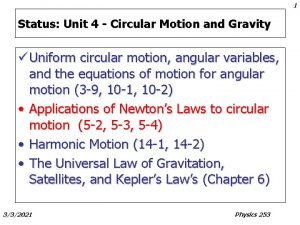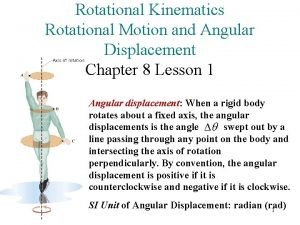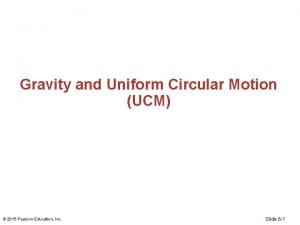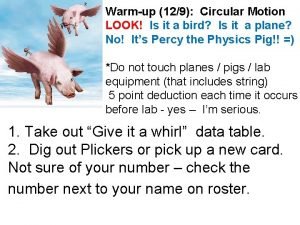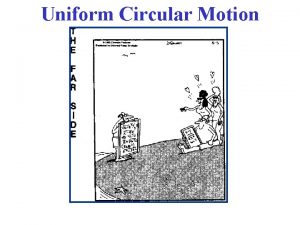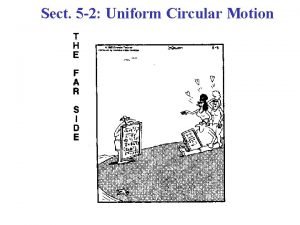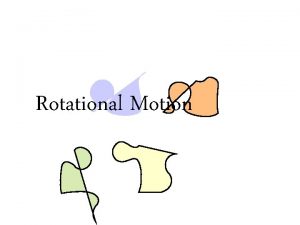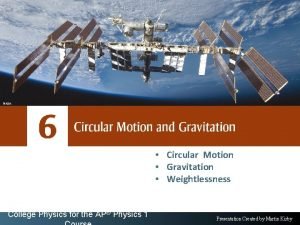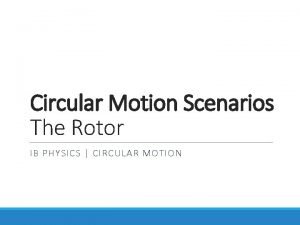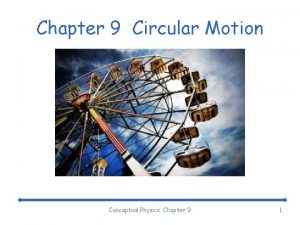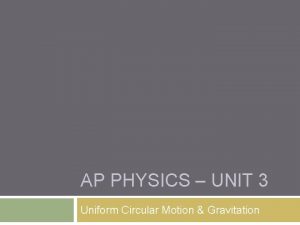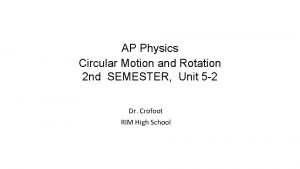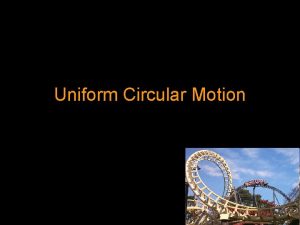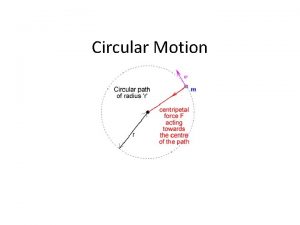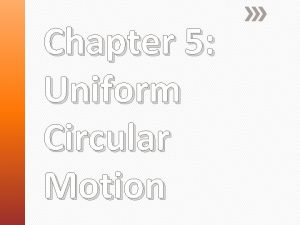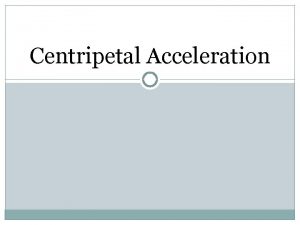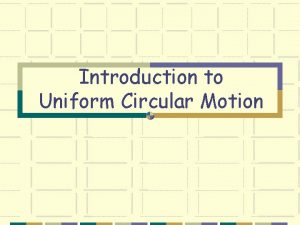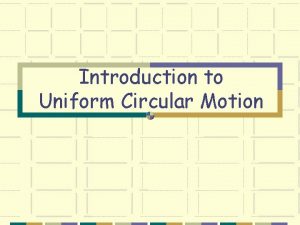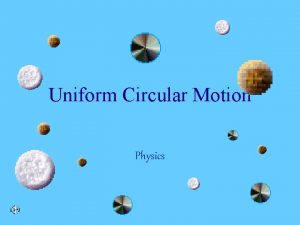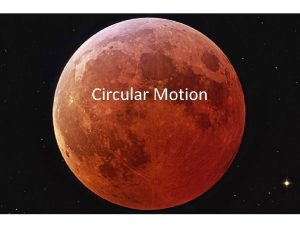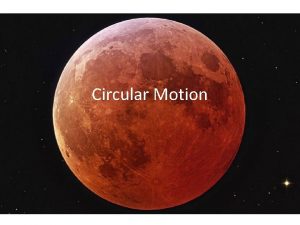Uniform Circular Motion AP Physics Linear Motion n

















- Slides: 17

Uniform Circular Motion AP Physics

Linear Motion n Linear motion was defined by the terms: q q q n Displacement Speed (Velocity) Acceleration That same basic approach will be applied to the study of rotational motion.

Speed in a Circle n Consider an object moving in a circle around a specific origin. The DISTANCE the object covers in ONE REVOLUTION is called the CIRCUMFERENCE. The TIME that it takes to cover this distance is called the PERIOD.

Speed with direction in a Circle n n Speed is the MAGNITUDE of the velocity. Speed may be constant, the VELOCITY is NOT. q q Velocity is a vector. The direction of the velocity is ALWAYS changing. n We call this velocity, TANGENTIAL velocity as its direction is drawn TANGENT to the circle. q This is a linear quantity.

Frequency n The FREQUENCY of a wave is the inverse of the PERIOD. That means that the frequency is the #cycles per sec. The commonly used unit is HERTZ (Hz). q Hz = 1/s

Angular Quantities n When talking about rotational kinematics the following terms will be used. q Angular displacement (θ) n q Angular speed (ω) n q rad/s Angular acceleration (α) n rad/s/s n For motion in a circle of radius r, the circumference of the circle is C = 2πr. The period for one rotation is T. * One complete revolution is 2π radians (360° = 2π rad)

Linear to Rotational Equations n Linear speed n Angular speed n Units rad/s Angular acceleration q n Acceleration q Units rad/s²

More Equations n Linear Kinematics v = vo + at Δx = vot + ½at² v² = vo² + 2 ax n Rotational Kinematics ω = ω0 + αt Δθ = ωot + ½αt² ω² = ωo² + 2αθ All linear kinematics equations can be converted into rotational kinematics equations by just plugging in the rotational symbols into the equations.

How are Angular and Linear Quantities related? n Tangential Speed q q n Direction is tangent to the circle of revolution. Radius times angular speed. Tangential Acceleration q q Same direction as the tangential speed. Radius times angular acceleration. How do you determine linear distance from angular displacement? Linear and angular quantities are related by the radius of revolution.

Angular Speed and Period Linear to Angular n Linear speed equation: n The angular speed is contained in the above equation. Angular Speed with Period n Also known as angular frequency

Speed and Frequency n Since 1 rev/s = 2π rad/s, then the frequency of an object undergoing circular motion is related to angular speed by: • Remember: frequency is cycles per sec. • A cycle and a revolution are the same thing.

Rotational Practice n A ceiling fan is running on a medium speed at a rate of 20 rev/s. The fan is turned to high and reaches an angular speed of 30 rev/s in 2. 2 s. 1. 2. 3. 4. 5. Convert the speeds of the fan into rad/s. What is the angular displacement (in radians) of a ceiling fan blade during this time period? What is the angular acceleration of the fan during this time period (in rad/s²)? While on the high setting, what is the period of a fan blade? A bug is hanging onto the end of the fan blade, 40 cm from the axis of rotation. Determine the linear speed of the bug when the fan is on the high setting.

Answers 1. 2. 3. 4. 5. 126 rad/s 347 rad 29 rad/s/s 0. 033 s 76 m/s 189 rad/s

Constant Speed Acceleration is constant n n n How is this possible? Constant changing direction of motion Circular motion at a constant speed has a constant inward acceleration (known as centripetal acceleration) Acceleration is zero n n How is this possible? Linear motion with a constant velocity (law of inertia)


Many Quantities n Velocity q q Tangential (v) Angular (ω) n Acceleration q q q Tangential (a) Angular (α) Centripetal (a ) Linear and angular quantities are related by the radius of revolution. c

Total Linear Acceleration? n Tangential and centripetal acceleration are both linear quantities. q n Always 90° apart. There is a total linear acceleration as well. q Found by adding the two (tangential and centripetal) linear accelerations vectors together.
 Which type of motion
Which type of motion Uniform circular motion lab
Uniform circular motion lab Non uniform circular motion
Non uniform circular motion Learning objectives for newton's laws of motion
Learning objectives for newton's laws of motion Non uniform circular motion examples
Non uniform circular motion examples Dynamics of uniform circular motion
Dynamics of uniform circular motion Acceleration vector projectile motion
Acceleration vector projectile motion Si unit of angular velocity
Si unit of angular velocity A car turns a corner on a banked road
A car turns a corner on a banked road Acceleration in circular motion formula
Acceleration in circular motion formula What is uniform circular motion
What is uniform circular motion Constant speed in circular motion
Constant speed in circular motion Circular motion time formula
Circular motion time formula Circular motion images
Circular motion images Rotor physics
Rotor physics Chapter 9 circular motion answers
Chapter 9 circular motion answers Unit 3 circular motion and gravitation
Unit 3 circular motion and gravitation Ap physics circular motion
Ap physics circular motion
